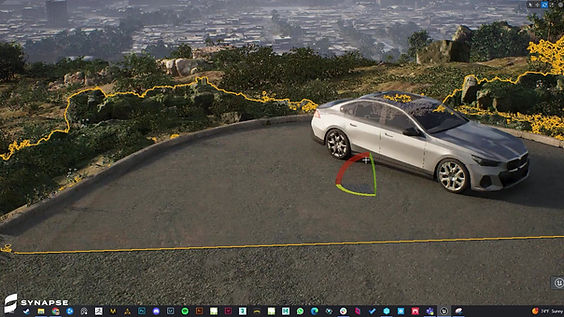
LEARN ABOUT
VIRTUAL PRODUCTION
Virtual Production (VP) encompasses cutting-edge technology that enables In-Camera Visual Effects (ICVFX) in ways never before seen.

Virtual production blends traditional filmmaking techniques with real-time technology—allowing actors to perform on physical sets, real locations, or LED stages while surrounded by digital environments. It bridges the gap between practical production and visual effects, incorporating everything from green screen and rear projection to car process, forced perspective, and digital set extensions.
While much has been said about VP’s potential, there’s a surprising lack of practical guidance—especially for smaller-scale productions like commercials, music videos, or short narratives. Synapse fills that gap, helping teams understand how to actually implement VP under real-world constraints like tight timelines and limited budgets.
THE VOLUME STAGE
& UNREAL ENGINE
We are at a moment where real-time visual effects and live-action photography are merging. As a film production paradigm, virtual production is still very much in its infancy and is largely being dictated by technology and less by artistry.
However, at its core, VP is driven by a state-of-the-art soundstage that utilizes large wrap-around LED walls (and ideally a ceiling) to display various forms of motion backgrounds – such as virtual environments generated in real-time from 3D video game engines like Epic Games’ Unreal Engine, filmed 2D live-action plates, or other forms of environment scans cued from media servers – that surround the live-action “foreground” elements to be filmed within a “volume” space.


CAMERAS
& TALENT IMMERSION
The camera of your choice is then tracked within the volume and its movements are translated to the Engine to drive the virtual environment, enabling realistic full 3D parallax of objects and environments on the screens. This allows the actors, sets, vehicles, etc. to feel as if they coexist with and within those virtual setpieces.
Unlike a tedious greenscreen setup, the talent doesn’t have to imagine that they are on another planet, they can see and feel the environment all around them. And it isn’t static… it’s animated, alive… It even provides the appropriate ambient lighting of that environment onto the sets and the actors.
WHY VP OVER
OTHER METHODS?
The technical aspects of Virtual Production can feel overwhelming… The terminology, confusing… The process, strange. But when it’s working to its ideal, filming on a VP stage should feel much the same way as shooting on a traditional location or set built on a stage… BUT without all the headache that comes along with such real world endeavors. On a VP LED stage, there’s no more weather days, no “chasing” the light… You can be on the summit of Mt. Everest, but have complete control of the shooting environment. Any world – no matter how small or epic – can be created.

This revolutionary process integrates multiple arenas of filmmaking – not just film and television, but also live broadcast, esports and immersive experiences – under one unique production umbrella. And by moving this mélange of disparate techniques to a VP stage, it enables the actors – and in some ways even more importantly, the filmmakers – to see and experience them in-camera, and thereby regain control of those elements, factor them in their compositions and then focus on what’s most important… capturing the performances.